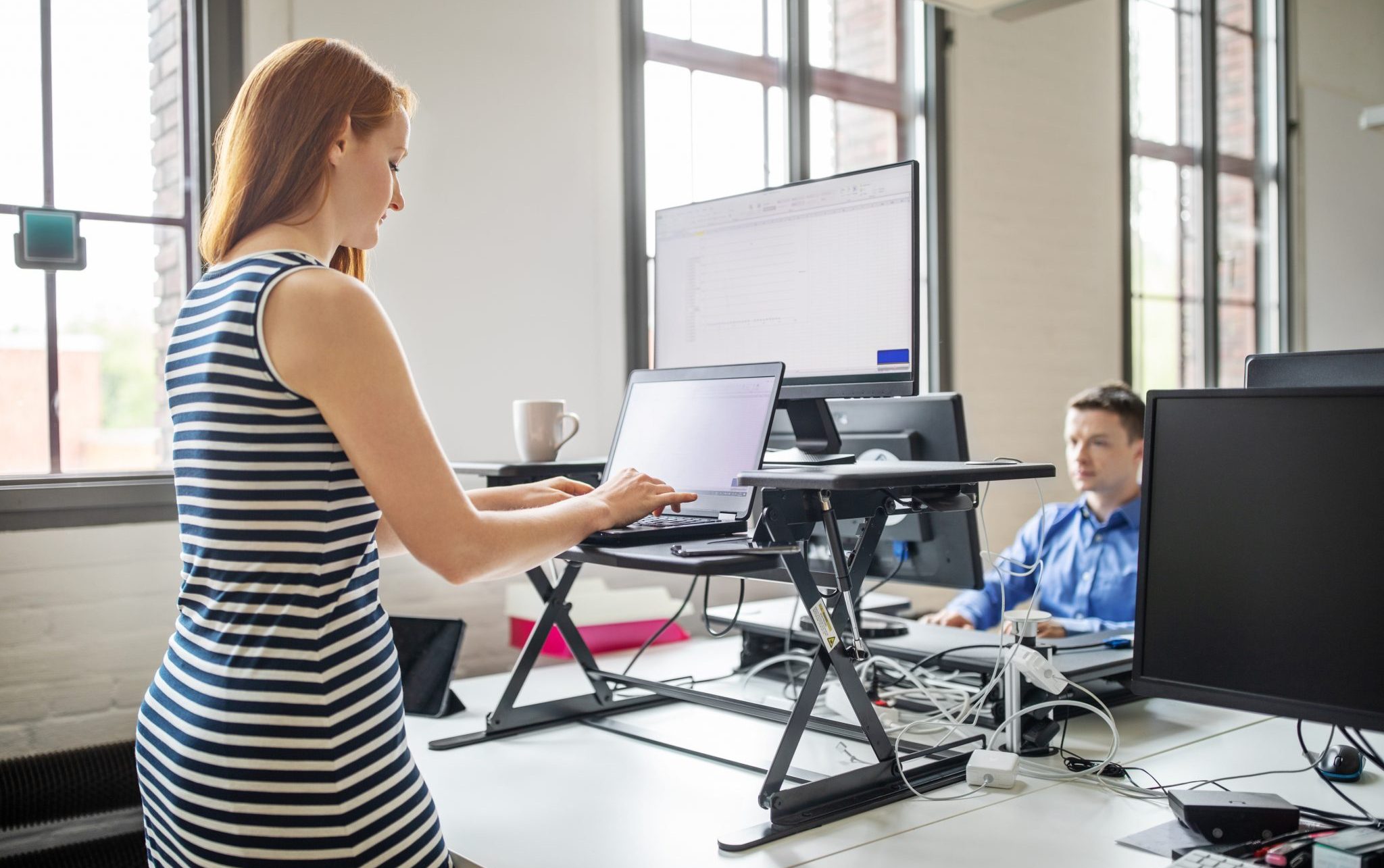You’ve probably heard about working in a standing position. These days this alternative to sitting is getting more and more popular. One of its undeniable benefits is that you put large muscle groups to work, boost your metabolism and burn more calories in comparison to when you are sitting. Furthermore, when you work standing, you go easy on your lower back – it’s under two times less pressure than when you sit at your desk.
Interestingly, when you look back at history, you learn that many renowned people preferred to work standing up. Among history’s famous standers were Nikolai Gogol, Ernest Hemingway, Winston Churchill, and many others. Peter I of Russia preferred to do everything standing up, Napoleon, Mendeleev, Gogol and Pushkin, and almost all people until the early 20th century did without chairs, because many schools during that period often didn’t have any sitting arrangements.
Stand-up desk in a nutshell
A stand-up desk is a piece of furniture which is usually a part of your study or an office. Basically, it is a high writing table at which you can draw, write, embroider and do a myriad of other things standing. Simply put, the stand-up desk is a high table. And it is so high, there’s no way you can sit behind it. At one point, people believed that an upright position was the only way to maintain good posture. That’s why private school students did their homework standing behind their desks at all times.
The only thing that reminds us now of the desk that once existed, is a lecturing desk, behind which professors give their lectures while standing. But the world is constantly changing, as well as it changes back. And so, what we witness now is a stunning comeback of the stand-up desk in the Western world.
It goes without saying that a chair can make you suffer, meaning that sedentary work is dangerous, you can even hear some people refer to it as the new smoking. A decade ago, American doctors even came up with an expression: Sedentary Death Syndrome.
Where do you start?
It is quite simple. You can make your very own test version of a stand-up table in under 5 minutes. Put a small stool or an upturned chair on the table, and a flat sofa pillow on top of this construction. You can work with elbows on the tabletop. That’s why it is important that the tabletop is located at a comfortable height.
There are ready-made solutions, of course. The most obvious example is Bekant table from IKEA. The table is easily adjustable – at any time it can be either lowered or raised higher. It is designed after a study that found that sedentary work is very harmful to the spine.
Benefits of standing vs. sitting at work
- Large muscles are at work (improved metabolism)
- Less pressure on the lower back
- Increased physical activity
- Reduced stress levels. Our bodies produce more testosterone and less cortisol when we work standing up which stimulates mental and emotional activity. The standing position is usually called a ‘strong pose’.
- Reduced risk of problems associated with a sedentary lifestyle.
- You burn more calories. Standing work burns 1.36 times more calories a minute than sitting, more than 60 calories per every hour of standing. In eight hours’ time you can lose around 500 calories, which makes a huge difference, especially if you’re after weight loss.
Pay attention to detail
- Stand on a mat either barefoot or wearing comfortable footwear.
- Optimal tabletop height – it needs to be at a bicep level, and the tabletop must be rather spacious and with a roundish edge.
- Move: you are welcome to shift the center of gravity, move away a little and then return.
- Pay attention to the angle of the monitor when you're working standing behind a computer. Working at a stand-up desk benefits eyesight, since the working angle of 15–17° is much better for the eyes than a horizontal surface. Working behind a standing desk has a number of peculiarities which both teachers and parents should pay attention to.
What should you stand on?
1. On an anti-fatigue standing mat
Standing comfort mats help people endure long hours of standing at work without any unpleasant consequences to their health. They help ensure you always have a firm and safe footing, and are usually made from durable rubber.
2. On a treadmill
This is an advanced option. Of course, it’s pretty hard to focus this way, but it’s totally doable to complete some routine tasks while walking or running on a treadmill.
Possible complications of standing
- The first and foremost problem is in our head. By that I mean that we are afraid we might be frowned upon or misunderstood by other people. If it's the case, you can go with one of these lines: “It’s for my back”, or “It was prescribed by my doctor” (i.e. me), or you can say it’s an antique desk used in early 18th century schools and you are just resurrecting a good tradition. Nothing new.
- This lifestyle is sometimes reproached because of the risk of venous disorders. But the fact is that no one forces you to sit all the time, it is important to change the rhythm: stand, sit, and even lie down.
- When you start working standing, your legs will hurt at first. This is completely normal. You may feel pain during the first 3 to 4 days. To avoid that, do squats every hour and it will get easier. When you lie down to rest – throw your legs above your head (for example, on a chair) for 15 minutes.
People who prefer to stand at work
More and more people prefer to do their job standing. Australia has recently become a pioneer in introducing stand-up desks to their workplaces in a large-scale movement. Denmark is not that far behind, obliging employers to provide standing workstations to their employees, if the latter want them to. The USA and Japan are making noticeable progress in that direction as well.
More and more IT Specialists have been spotted working standing up. Among them are former Twitter developer and BankSimple founder Alex Payne, Instapaper founder Marco Arment, popular podcaster Dan Benjamin, writer Philip Roth, former Defense Minister Donald Rumsfeld, and Lifehacker Editor-in-Chief Jason Fitzpatrick.





